by Jody Argo Schroath
The long fight for Alexandria’s waterfront
Kathy and I were in Alexandria surveying the enemy. I had persuaded my chum and occasional cruising companion to come along as I assessed the city’s waterfront development battlefield firsthand. Since I didn’t have a dog in this hunt, I was more like a foreign general—let’s say Lafayette since I can’t spell Kociuszko—than a local warrior. Still, as we stood along the bulkhead of Ford’s Landing on an indisputably perfect June day and looked across the Potomac River at National Harbor’s formidable artillery—the National Wheel, Gaylord Convention Center, and a seemingly impregnable wall of hotels and condominiums—I could feel my sympathies bend under the strain.
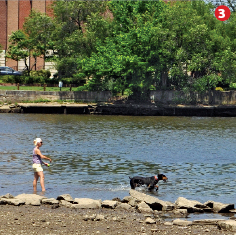
Around us, on the Alexandria side, lay one of the last “undeveloped” (that is, undeveloped by developers) big city waterfronts around. Flawed though it might be with its high-fenced warehouses and rickety wharves it was what it was: the vestigial remnant of a 300-year history of maritime industry and trade. And behind that imperfect facade lay the architectural treasure-chest that is Old Town Alexandria.
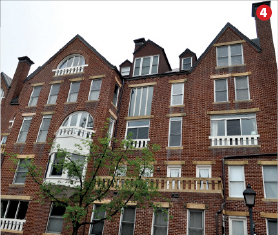
Block upon block of narrow tree-shaded streets with names that read like a lesson in royal succession: Duke, Prince, King, Queen, Princess. And within each block a world within a world of red brick homes and rowhouses, private mews and secret gardens. Very English. Very introspective. Very quiet.
Quiet, that is, until threatened—in this case by “development” of its cherished resources—when residents take up arms, hire lawyers and wage war. That’s what happened thirty years ago when the city wanted to demolish two dozen blocks of old buildings and refashion the waterfront into high-rises and condos. An outcry from residents and a suit by the federal government managed to quell both the destruction and the development. (More on that a little later.)
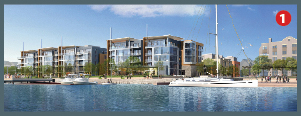
Things settled down for a few years. Old Town became popular—a favorite tourist spot, in fact—and its real estate prices soared. But at heart, it remained the same. Then at the beginning of this decade, when the city began to draw up plans for a very different waterfront, one that included modern buildings, several hotels and condominiums, retail space and a park and pathway system that spanned a waterfront uninterrupted by warehouses and chainlink fences, a number of Old Town residents again took up arms. This time the rallying cries were “Don’t make Alexandria another National Harbor” and “Too big, too fast, too soon!”
1) This is what the waterfront side of EVA development’s complex of retail, restaurant and living space will look like at Robinson Terminal South.
2) Here is the side-view plan for the new Dominion Boat Club, which will be built at the old Beachcomber site.
3) This Olin Studio design sketch shows a layout of the area around the City Marina, with the new Fitzgerald Square just to its left.
4) A man and his dog take a late-morning stroll along the path in front of the newly opened Oronoco Park Condominiums in the former Sheet Metal Workers Union building.
5) A public hearing notice for Robinson Terminal South.
6) One area of the old Robinson Terminal South warehouses. For a view of their planned replacement, see rendering 1.
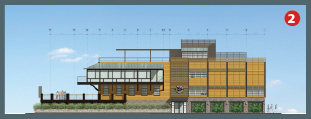
Over the next few years, under the leadership of groups such as Friends of the Alexandria Waterfront and Citizens for an Alternative Waterfront Plan, and supported by legal suits brought by three Old Town residents known as the Iron Ladies, they fought the good fight. Washington Post articles at the time routinely referred to it as a “pitched battle.” Occasionally they won a few concessions, like fewer hotels with fewer rooms and redesigned retail/residence complexes, but they lost all the big votes by the Planning Commission and City Council. And, in January 2012, the council approved the Alexandria Waterfront Small Area Plan on a 5-2 vote.
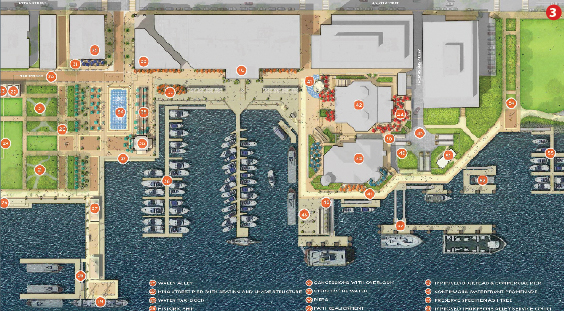
The war was winding down, but even then, the city was reluctant to move forward until all the suits against it were settled. The end came this spring, when the Virginia Supreme Court ruled against the Iron Ladies’ final appeal on their suit claiming that the council had wrongfully denied their petition for a supermajority on final passage of the waterfront plan. The war over the waterfront was ended.
“Not that the new Alexandria waterfront is going to come out with a big Ferris wheel, a Peeps store and great tall buildings,” I told Kathy as we walked north, skirting the Old Dominion Boat Club at the foot of King Street—Old Town’s busy avenue of shops and restaurants. “There will be a significant amount of glass, however,” I added. “To begin with . . .”
“Wait,” Kathy said, holding up a warning hand. “Tell me over lunch. I’m starving!”
She immediately ushered me past the 450-seat Blackwall Hitch Restaurant, which was still under construction on the old food court site (it’s open now), and up the steps of the Chart House, which overlooks the city marina. “This will do fine,” she said. “You would never have been able to make up your mind.”
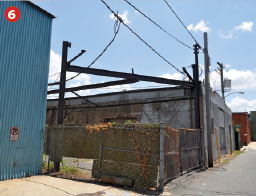
True, Old Town has a lot of neat restaurants.
“We’ll have iced tea and crab tater tots to start,” she told the waitress after we were seated. I nodded. “Fine.”
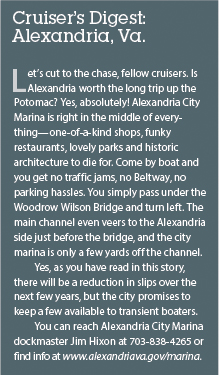
“Okay,” Kathy said after our tea had arrived. “You’ve told me about the war, but now tell me what’s actually going to change. For example, what’s going to happen to all this?” She swept her hand around the marina below us, where a handful of tour boats and a paddle-wheel steamer shared dock space with the usual array of sailboats and powerboats.
“You’ve hit me in a weak spot,” I said. “Nobody quite seems to know, except they’ll have to find room to squeeze in more commercial boats, which will be moved here when the old wharves are knocked down. And those two piers at the south end of the marina will be turned over to the Old Dominion Boat Club for a few years, until they build new docks of their own at their new location.”
“That sounds kind of tough on the slipholders,” she said. “What about transients, like you?”
“Well,” I said, finishing my iced tea and looking around for a refill, “I talked to the city dockmaster, Jim Hixon, about that this morning, while you were wandering around the Torpedo Factory. He doesn’t know, he said, in fact nobody knows just what will happen yet. But the upshot is that nothing significant is going to happen to change things for the next three years or so.”
“Except for Piers A and B.”
“Yes,” I said. “And the realignment for flooding project.”
“Hmm?”
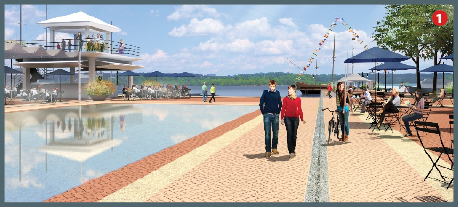
I explained that when I had talked with Jack Broward, division chief of the Parks and Recreation department, the other day, he had said that although there would be a temporary decrease in the number of slips, in the end the city would work it out. Broward had also told me that life at the marina would also be disrupted during the city’s project to mitigate the frequent flooding of its waterfront streets, including the marina area. This would probably entail “realigning the marina.”
1) An Olin Studio rendering of the new Fitzgerald Square park on King Street shows the observation platform and the fountain/reflecting pool/event space.
2) A couple strolls near the old Beachcomber Restaurant and later a gun shop. This will soon make way for the new Old Dominion Boat Club building.
3) Sculptures seem to keep an eye on each other in an artist’s gallery in the Torpedo Factory Art Center.
4) Bicyclers and diners enjoy a sunny day outside Chadwick’s Restaurant in Old Town.
“Mmm, great tater tots,” Kathy enthused.
“I’m listening,” she said when I looked annoyed. “You keep talking. Tell me about the boat club.”
“Ah,” I said, somewhat mollified, “the Old Dominion Boat Club was the last piece in the city’s chess game to connect the city’s waterfront with an unbroken series of paths and parks.”
“Chess? I thought we were talking about war?”
“Well, it was a kind of war,” I said, “more like a Cold War.” For years, the city has coveted the club’s location at the end of King Street—a spot it has occupied since the 1920s. The club’s parking lot occupies one side of King Street and its clubhouse the other.
“Yes, I did notice that,” she said, “with a tiny park in between.”
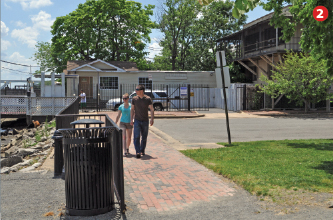
That little park was established after the city reclaimed the end of the street from the club, which at some point had fenced it off for the use of its members. “Of course, in those days, nobody much wanted to be down there anyway,” I said.
In any case, Old Dominion was just as determined to hold onto its location as the city was to unseat it in order to create a park to anchor Old Town’s key street.
Over the years the city and the boat club talked, and several times they nearly, but not quite, reached an agreement. So the city had its design firm, Olin Studios, draw up waterfront plans both with and without the Old Dominion property.
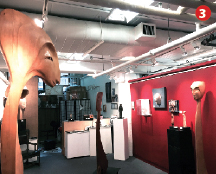
Finally, this past winter, the two sides reached an agreement. For $5 million the city got its keystone property. In exchange, the boat club will take over the old Beachcomber Restaurant property, just to the south. There they will build a new clubhouse, parking lot and docks, all with a city-built public walkway running along the water in front.
On its newly acquired street-end property, the city will create Fitzgerald Square, a multi-use park with a viewing platform, a long pier and a fountain that can be converted to a reflecting pond or an ice rink, or disappear altogether to become an entertainment stage or special event area.
“Best of all,” I said, grabbing the last crab tater tot, “from the city’s point of view, it will become a natural gathering place and an entryway to the expanded and improved waterfront park system.”
“That sounds pretty nice. I don’t see much to complain about there.” Kathy said, reaching for her fork as her Frutti di Mare salad arrived. “Mmm, mussels, calamari, shrimp.”
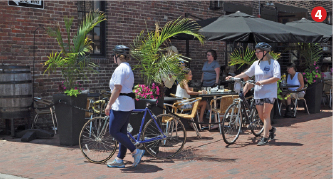
“The big problem with the whole plan for many people is one of scale,” I said. The complaint about Fitzgerald Square has been its size, which some residents have argued is too big for Old Town’s small-scale homes, streets, shops and streets. “The opposition maintains that it’s being built more for tourists than residents,” I continued. “And they feel that the fountain, viewing platform and other features compromise the small-scale historical feel that makes Old Town special.”
In fact, size and scale is at the heart of the opposition to much of the waterfront plan. Take for example the two large warehouse complexes that until recently belonged to the Washington Post Co. and were both used primarily to store monster rolls of newsprint. In 2013, the warehouses were sold to two development companies and will soon be demolished. What replaces them will have the largest impact on the city’s new waterfront skyline.
City Interests Inc. bought Robinson Terminal North, which occupies the waterfront between Founders Park to the south and Oronoco Park to the north. Earlier this year, the Board of Architectural Review (BAR) approved its design for two buildings. The East Building will be four stories of glass and masonry (mostly residential) and a two-story pavilion of glass, metal and stone (for retail). It will be quite unlike anything else on the Alexandria waterfront. The five-story West Building will look more traditional (red brick, stone and wood), and house a mix of retail and residential, along with a small hotel. Once approved by the BAR, plans go before the Planning Commission and finally the city council.
Developer EYA is the new owner of the three-and-a-half acre Robinson Terminal South complex, which lies along Duke, Union, Wolf streets and the Strand, Alexandria’s old waterfront street. All but one of the old terminal buildings will be razed—that one, a small historic red-brick building, will be preserved. In their place, EYA will build two buildings that will combine condominiums and other residential space, a restaurant and retail space. There will also be six rows of townhouses. These buildings, like Robinson Terminal North, combine traditional red-brick walls facing the city with glass fronts along the waterfront. This plan has passed all reviews, including a 5-2 vote from city council.
Both complexes, of course, include public-access walkways along the waterfront. And before passage, both were the subject of hot debate over their size and non-traditional design, not to mention the increased traffic and congestion they will bring.
“I did like what EYA did with the old Sheet Metal Workers Pension office building on Oronoco Bay Park,” Kathy said, as she tried to catch the waitress’s eye to order dessert.
It’s little wonder she was impressed. EYA has converted the old building into luxury condominiums that overlook both the park and the Potomac River. Prices started at more than $1.5 million for the small ones and went way up from there. Nearly all 60 units were spoken for before the building even opened. EYA has also pledged $20 million to the city’s plan to install public art in its parks.
“The other big private project in the works is a boutique hotel that will be built on Union Street,” I said. “That’s the site of the old Cummings-Turner warehouse.”
“Just this side of Robinson South,” she said, surprisingly, I thought, since I’m never sure whether she’s paying attention while we’re walking or just looking for restaurants.
Plans for a 120-room, four-story hotel and restaurant have made it all the way through the approval process, despite complaints that its design does not fit into its Old Town surroundings. The hotel will be owned by Carr Hospitality and named Hotel Indigo, one of the company’s hotel brands.
“Is that it?” Kathy asked, at the same time pointing to Chart House’s signature dessert, Hot Chocolate Lava Cake, on the menu. “And coffee.”
“That’s pretty much it for the private part,” I said. “And since most of that is pretty far along in the permitting process, it will probably be completed within the next few years. The new boat club first and then maybe the hotel. The rest to follow.”
“What about the city’s end of the project?”
“That’s going to take a lot longer,” I said, “Certainly as long as ten years, maybe considerably longer.”
At $120 million, money, of course, is a major hurdle, as are infrastructure issues, which the city intends to address first. Foremost among these is fixing that flooding problem. Then there will be bulkhead repairs and replacement of some weak pilings at the city marina. After that, the city can get down to the business of naturalizing the waterfront, acquiring art for its parks, building walkways and paths and expanding and landscaping generally.
During the planning process, arts and historical groups were asked for ways these elements could be incorporated into the plan. The result is that public art will be part of the entire waterfront park system, with each park identified with a theme based on either the history of the specific spot or on Alexandria’s history as a whole. The city’s waterfront history in particular will be remembered as well throughout the parks with markers and signs.
There’s a lot to commemorate. Since the earliest days of European settlement, Alexandria was a bustling city of trade and industry, its natural harbor crowded with ships, its warehouses full to bursting with tobacco and foodstuffs. Shipbuilding, fishing, baking, trading. Until the Civil War, when the city was immediately occupied by Union troops and its waterfront businesses co-opted, Alexandria seemed destined to be one of the nation’s principal ports of call. Even after its long recovery from the “recent unpleasantness” (as some locals call the War Between the States), when the city’s waterfront was once again the heart of its economy, it soon lost out to larger, more convenient ports such as Baltimore, Philadelphia and Norfolk. By the middle of the last century, its waterfront had fallen into decline.
“Things had reached such a sorry state that by the early 1970s,” I said, watching in awe as Kathy polished off the last of her chocolate lava cake, “that city council decided to demolish twenty-three blocks of historic buildings and to allow developers to put high-rise office and apartment buildings along the waterfront.”
The city managed to raze six blocks of old buildings before a hue and cry from residents succeeded in stopping the bulldozers. Notable among those voices in opposition was Ellen Pickering, who also petitioned the federal government to create a national park along a mile and a half of city waterfront. Although the National Park Service declined to create the park, Pickering’s application was at least in part responsible for a suit brought by the federal government against the city in 1973 claiming ownership of the waterfront.
“Wait, what’s the federal government got to do with the Alexandria waterfront?” Kathy asked.
“Interesting story,” I said. Alexandria was originally part of the District of Columbia. When residents changed their minds in 1846 and wanted to be part of Virginia again, the new District line was drawn at the Virginia shore of the Potomac. Because the city’s waterfront businesses made a practice of building out into the river, filling in as they went, the new land thus created could quite arguably be considered a part of the District. So the federal government sued the city over the public’s right to access to the waterfront, and in 1981 the two parties settled (finally). The result was the city’s first comprehensive waterfront plan, which established a string of waterfront parks, including Founders and Oronoco Bay, and established low-density zoning and height restrictions in Old Town.
The experience made Old Town residents wary of city plans for urban renewal, which in turn helped stoke the fires of opposition in 2011 when the city wanted to raise density and square-foot limits to allow development of the Robinson Terminals space and the site of the new Hotel Indigo. Opponents did manage to wring a reduction from the proposed three hotels and a total of 450 rooms to two small hotels and a total of 300 rooms. They also won some design changes, but that is about all.
Or so it seemed. In the largely Democratic-controlled city council and mayor’s office, Alexandria’s primary elections often decide the outcome of the general election. So when recently elected vice-mayor Allison Silberman edged out long-serving and generally popular Mayor William Eullie in a three-way primary race this June, it seemed like a victory for opponents of the plan. Since her election to council, Silberman has voted against the plan itself and many of its individual parts, often casting the sole “no” vote. If she prevails in the general election, which seems likely given that she has no opposition—at least so far—her effect on implementation of the plan will be interesting to see.
“As everyone I’ve talked to has pointed out,” I said, “although the bones of the plan are in place and approved, there are a thousand details yet to be worked out.”
Kathy and I walked out of the Chart House and paused once more to look at the Potomac, sparkling cheerily in the bright sunshine.
“I have an idea,” Kathy said. “Let’s take the water taxi to National Harbor. I hear there’s a big sale going on at the Peeps Store.”
[ August 2015 Issue]